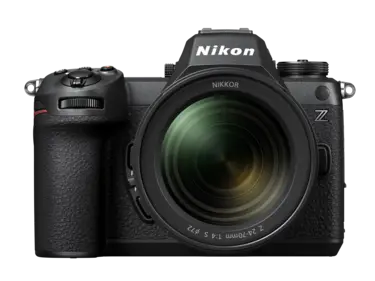What lenses and bodies do I need for vlogging?

A guide to DX and FX, kit and next-step lenses and those all-important accessories
Camera Bodies
Your camera body is the base of your kit. Whether you go crop sensor (DX) or full frame (FX), there have never been more options for good vlogging cameras.
DX
DX bodies are good budget or beginner cameras and come packaged with a capable kit lens to start your video journey. The Nikon Z30 was made with content creation in mind with 2+ hours of continuous recording time and the ability to film up to 4K/30p and 1080/120p HD. It even has a vlogging kit option with everything you need to get started.
The Nikon Zfc is a step up from the intro level Z30, offering the same 4K video capture and frame rate options with a retro aesthetic inspired by 35mm film cameras. You can choose from one of three kit options, including a vlogging kit.
Nikon Team
The new Nikon Z50II is the latest DX camera in the range and has advanced features, including a dedicated Picture Control button to cycle through image ‘recipes’ to create different looks and autofocus and subject detection equivalent to the flagship Nikon Z9! Vlogging features include the new Product Review mode, which automatically focuses on an object held up to the lens, the ability to zoom even with a fixed prime lens and livestreaming direct from USB to laptop or smartphone – no extra software required.
Both camera bodies have a vari-angle screen that’s ideal for recording yourself.
Read more: How to vlog for beginners with Cathrin Manning and the Z30

FX
FX camera bodies come with more bells and whistles, more accessory options and more under the hood.
The Nikon Zf gives you the retro aesthetic and controls of the Zfc with a full-frame sensor and much more technology under the skin. In-camera Vibration Reduction helps stabilise your shot even if you can’t shell out for a gimbal. You can see yourself on the flip-out screen, record in 4K video, and capture slow motion. And it comes in multiple colours, which is a nice bonus.
If you want even more features and don’t mind spending a little extra, you can try the Nikon Z6III. It records up to 6K video and has line inputs to attach high-quality sound equipment such as a pro shotgun microphone. And, of course, it has the all-important flip-out screen.
Read more: What mirrorless camera is right for me? Z30 to Z9 explained
Lenses
Whether you’re interested in stills, video or both, your lenses are an important investment. The right ones will stay with you for years.
Kit lenses and zoom lenses
The first lens most people get comes in the box with their camera kit. Z series kit lenses get respectable results while providing a variety of focal lengths.
For DX cameras, the NIKKOR Z DX 12-28mm f/3.5-5.6 PZ VR is a solid option that’s perfect for filming. The wider angle lets you film yourself even in smaller spaces. It’s also compact, lightening your camera kit when you’re on the go and the super-quiet power zoom function allows for smooth, controlled zoom shots in video. If you prefer a zoom that covers ultra-wide to standard focal length, select the NIKKOR Z DX 16-50mm f/3.5-6.3 VR for filming both sweeping landscapes and flattering portraits.

Read more: What is focal length?
If you’ve got a little more to spend, a fixed-aperture zoom such as the NIKKOR Z 24-70mm f/4 S (a great value kit lens for Zf and Z6III) is worth a look. A favourite zoom of vloggers, the 24mm wide angle lets you film in small spaces while the variable zoom makes much tighter shots possible. Fixed-aperture zooms such as the NIKKOR Z 24-70mm f/4 S maintain a wide aperture through their zoom range – essential for beautiful bokeh and low-light scenarios.
Read more: What is bokeh and how should I use it?
Prime lenses
Prime lenses have a fixed focal length, meaning you can’t zoom in or out. Prime lenses are almost always faster than zooms because they offer wide apertures – the opening in your lens through which light passes to enter the camera. A wide aperture allows you to shoot when there is less light and also creates a shallow depth of field, meaning you get that lovely background (or foreground) blur or bokeh, while your subject remains in focus. It also gives all your shots a consistent look.
A good starter prime for DX cameras is the NIKKOR Z DX 24mm f/1.7 (36mm FX). The wide f/1.7 aperture makes it easier to film in dim lighting. It’s also very compact and, at 135g, it’s easy to carry.
For FX cameras, check out the NIKKOR Z 35mm f/1.4 for good standard focal length, excellent wide aperture and sharp image quality. It’s a relatively affordable prime, especially at a f/1.4 aperture, which you can use for various shots.
Primes such as the NIKKOR Z 50mm f/1.8 S let you get more close-ups while still being versatile and compact. If you’ve only got the budget for one good lens, you can’t go wrong with 35mm or 50mm.
Specialist vloggers filming insects, flowers, products or food will prefer the NIKKOR Z MC 50mm f/2.8 macro lens. With a minimum focus distance of just 0.16m, you can achieve sharp focus even when the front of this macro lens is 5cm away from your subject.
FTZ adapter
If you already have an extensive collection of Nikon F mount lenses, you can still use almost all of them (around 360) with your mirrorless camera using the FTZ II mount adapter.

Accessories
While you don’t need many accessories to start making content, they can give your videos some extra polish. Quality audio, for example, can take a video from good to great. The RØDE VideoMicro shotgun mic gives you much better sound than an in-camera microphone and is compatible with every camera listed here.
Read more: What sound captures do I need for videography?
You’ll need to store all that crispy HD video somewhere, so don’t forget to grab a memory card. Brands including SanDisk and Lexar make affordable memory cards with decent storage capacity. It’s also advisable to invest in a separate hard drive for your computer. For a full list of approved memory cards see here.
Stabilisers such as tripods are also important. Mini-tripods can fit on your desk, and more pro-level ones let you set up interesting angles overhead or at ground level.
Some affordable constant lights can help set the mood while filming and make your footage look more professional. Try some less pricey LED softboxes to start with and work up from there once you’ve mastered them. Of course, a good old-fashioned window provides excellent lighting, too.
Next steps
You don’t need everything on this list. It’s more of a guideline to help you choose what’s best for you. Build your kit around your filming needs instead of what’s popular right now and you’ll be set for a long while.
Need inspiration on how to get started? Here’s how to become a content creator
More in Gear
Featured products

Unlock greater creativity











